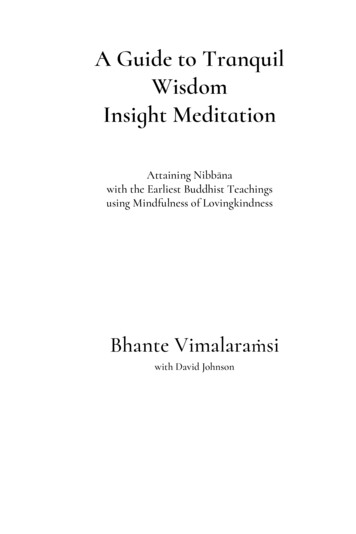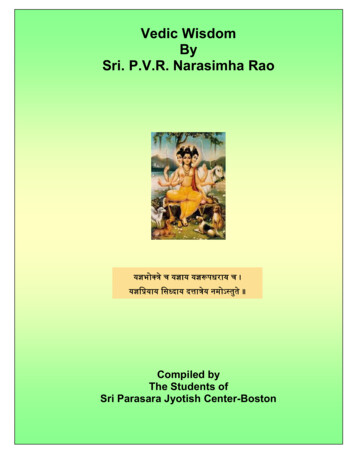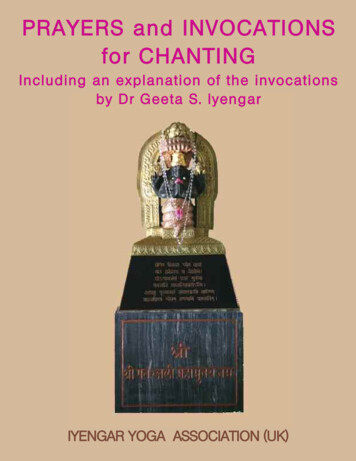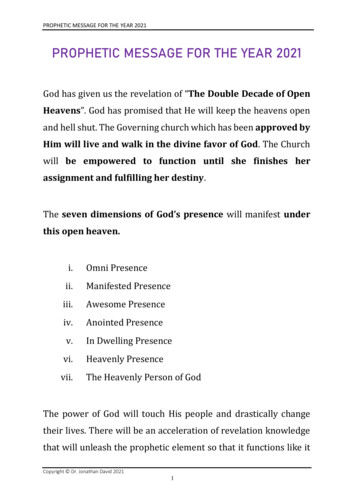
Transcription
A Guide to TranquilWisdomInsight MeditationAttaining Nibbānawith the Earliest Buddhist Teachingsusing Mindfulness of LovingkindnessBhante Vimalaraṁsiwith David Johnson
Copyright 2015 Bhante Vimalaraṁsi.All rights reserved.Publisher: Dhamma Sukha PublishingISBN-10: 1508569711ISBN-13: 978-1508569718Published: 1st Edition July 20152nd Edition: July 2017Other books by Bhante Vimalaraṁsi:The Dhamma Leaf Series, 2014Meditation is Life; Life is Meditation, 2014Moving Dhamma Volume 1, 2012Breath of Love, 2011Other books by David Johnson:The Path to Nibbāna, 2017 (the follow-on book tothis book with advanced practice and instructions)
For those who wish to experiencethe Cessation of Sufferingthrough the Elimination of Craving
ContentsIntroduction . 1What is Mindfulness? .4Why do we practice Mettā? . 6Beginning Posture . 8Beginning Lovingkindness Instructions. 9Smiling. 13Distractions . 14Hindrances . 17The 6Rs . 19Spiritual Friend . 25Forgiveness Meditation . 31Walking Meditation .32Keep it Going . 34Add Mettā to Everything. 36Progress and Jhāna .37Brahmavihāras and Nibbāna . 38Benefits of Lovingkindness . 41Mettā in Daily Life . 42Resources . 44Acknowledgements . 45Sharing Merit . 46
IntroductionThe purpose of this guide is to help someone who is new tomeditation, and the Buddha’s teachings walk the Buddha’s path tothe destruction of Craving and the elimination of Ignorance. Thisguide will provide you with the basic meditation instructions for thepractice of Tranquil Wisdom Insight Meditation (TWIM) as taughtby Bhante Vimalaraṁsi. TWIM is the actual Brahmavihāras practicedescribed in the suttas, and it includes the Divine Dwellings of Mindfulness of Lovingkindness (Mettā), Mindfulness of Compassion(Karuṇā), Mindfulness of Joy (Muditā), and Mindfulness of Equanimity (Upekkhā).The Brahmavihāras are described by the Buddha in his earliesttalks as recorded in the suttas of the Majjhima Nikāya1. The instructions in this guide are based on the suttas themselves and on commentaries that are consistent with the suttas. The instructions explain Right Effort — this is what we call the “6Rs”. The 6Rs will beexplained in detail later.Most Buddhist Mindfulness practices today tend to focus on thebreath as the object of meditation. They only use Mettā and the Brahmavihāras as “side meditations” to help one with relaxation and as away of “softening” the breath practice and of softening life in general.However, the Buddha discussed the Mindfulness of Mettā practicemany more times in the suttas than the Mindfulness of Breathing(Ānāpānasati) practice: only eight times for Mindfulness of Breathingand more than a hundred times for the Mindfulness of Lovingkindness.1The Middle Length Discourses of the Buddha , trans. Bhikkhu Bodhi and Bhikkhu Ñāṇamoli (Somerville, MA: Wisdom Publications, 1995).1
Although many teachers today do not teach this or support thisview, the Buddha did state that the Mettā and Brahmavihāras practice, on its own, will lead to the supreme attainment of Nibbāna. Thesutta Accompanied by Lovingkindness in the Saṃyutta Nikāya(46:54(4)) makes this clear.2Tranquil Wisdom Insight Meditation, using Mettā or the feelingof Lovingkindness as the object of meditation, has been found to beeasier and to give faster results than using the Breath as the object ofmeditation. It includes a powerful warm and glowing feeling, whichhelps your practice because you enjoy doing it. When practicing thismeditation, you are radiating Lovingkindness, and giving this feelingto others. This is building your generosity while simultaneously developing a greater sense of well-being and contentment. You are doing this not only while engaged in your formal sitting practice butalso throughout your daily life experience. This creates momentumfrom the time you get up in the morning until the time you go tosleep. This continuous practice can be very conducive to fast progress.TWIM includes an all-important step that is found in the suttasbut is misunderstood or left out of most Buddhist Mindfulness practices these days. This step is the key to the attainment of Nibbāna!You will learn more about this later; this is the Relax Step.This book is a guide to beginning practice. A deeper understandingof how TWIM works, descriptions of insights, levels of understanding that arise, and the sutta references that support this meditationare all beyond the scope of this booklet. The book Meditation is Life;Life is Meditation 3 provides that information in depth and detail.23See also our website www.dhammasukha.org for more discussion on this subject.Bhante Vimalaraṁsi, Meditation is Life, Life is Meditation (Annapolis: DhammaSukha Publishing, 2014).2
Other books like Breath of Love 4 and Moving Dhamma5 also offerskillful guidance once you are deeper in the practice. A book by senior student Doug Kraft, Buddha’s Map6, is another good reference forthe concepts and experiences of TWIM.456Vimalaraṁsi, Breath of Love (Jakarta, Indonesia: Ehipassiko Publishing)Vimalaraṁsi, Moving Dhamma, vol. 1 (Annapolis, MO: Dhamma Sukha Publishing, 2012). Vimalaraṁsi, Breath of Love (Jakarta, Indonesia: Ehipassiko Publishing)Doug Kraft, Buddha’s Map (Grass Valley, CA: Blue Dolphin Publishing, 2013).3
What is Mindfulness?The term “Mindfulness” has become commonplace these days andis often interpreted differently than what I believe was originally formulated by the Buddha.You may have heard that Mindfulness is watching what arises, divinginto it, and focusing firmly on it to understand the nature of whatarises. The idea is that concentrating more closely and harder on the“object of meditation,” will ultimately yield profound insights.However, that is not the Mindfulness that the Buddha taught; rather, that is called one-pointed concentration: absorbing your attention into an object.The Buddha learned from his experiences and described in sutta 36of the Majjhima Nikāya, the Mahāsaccaka Sutta, that one-pointedconcentration will quiet the mind temporarily, but it will not lead toan understanding of suffering and the cause of suffering, or toNibbāna. For that reason, the Buddha rejected absorption and onepointed concentration practices. Most teachers today miss thissignificant point. Yet sutta 36 does spell it out. The Buddha rejectedthe teachings of Ālāra Kalama and Uddaka Rāmaputta—teachers ofthe most advanced concentration states of the time. He left theirtraining to continue his search for yet another six years.Here is a short, clear, and precise definition of Mindfulness as theBuddha taught it:Mindfulness means to remember to observehow mind’s attention movesfrom one thing to another.The first part of Mindfulness is to remember to watch the mindand remember to return to your object of meditation when you havewandered off. The second part of Mindfulness is to observe howmind’s attention moves from one thing to another.4
Real insight is gained by watching how your mind interacts withthings, as they arise—not by observing the things themselves. Truemindfulness is remembering to observe how your mind moves andresponds to what arises in the present moment.With mindfulness, we can understand how things arise and passaway, from beginning to end. We do not care why things arise—thatis the concern of psychologists and philosophers. We only care abouthow they arise and how they pass away—how the movement of mind’sattention happens during that entire process.When mindfulness becomes strong, you start to understand whatCraving really is. Craving is what pulls your mind away from yourobject of meditation. Tensions and tightness arise with sensationsand thoughts. Craving is what starts the identification process inwhich you take something personally with an “I like it” or “I don’tlike it” mind.Mindfulness meditation is the process of observing how mind’s attention moves moment-to-moment. Mindfulness enables us to seeclearly and precisely how the impersonal process of thoughts and sensations arises and passes away.7 We identify with this process as ourselves; we take it personally. Seeing and understanding how mind’sattention moves from one thing to another, personalizing experienceand creating an “I” as it goes, is one of the most important insights ofthis practice. It develops an impersonal perspective on all arising phenomena and leads the meditator to see for themselves the true natureof existence. You finally answer the question, “Who (or what) am I?”The other important facet of mindfulness, once we have remembered and observed, is to catch ourselves when we get lost—toremember that we are supposed to “come back home.” More on thisas we explain the 6R process later.7The Buddha called this process Dependent Origination or Paṭiccasamuppāda.5
Why do we practice Mettā?As was said earlier, the Buddha talked about Mettā meditation farmore frequently than he talked about Breath Meditation, and hemade clear that Mettā meditation, as part of the Brahmavihāras, willlead to Nibbāna. Those are good enough reasons in and of themselvesto incline us toward Mettā meditation. Nevertheless, there are otherreasons as well.First, using the suttas as the guide, Dhamma Sukha teaches Mindfulness of Breath (Ānāpānasati) differently than other techniqueswhich are one-pointed. Breath practice that focuses and concentrateson the nose tip or belly is not found in the suttas. The Buddha neversaid to concentrate on the breath — he said to observe and to knowwhat the breath is doing in the moment and to observe what mind’sattention was doing as we are breathing. As the mind starts to wander away, this is where we employ the 6Rs, to softly, without anypushing away, bring back our observation to the object of meditation.8We would prefer that those meditators who have practiced BreathMeditation in the past use a completely different object of meditation. Otherwise, they may habitually revert to the way they weretaught, using what we very much consider “bad habits.” This can leadto confusion and a lack of progress. We prefer to avoid a practice thatrequires people to struggle against their old ways of practicing.Second, we find that Mindfulness of Mettā and the practice of theBrahmavihāras is easier because of the comfortable feeling of Mettā.This is especially important for the beginner, because Breath Meditation may be difficult to master since it is more of a mental exercise.With Mindfulness of Mettā, because of its pleasant nature, you can8For more information on how the Breath Meditation is taught by us, pleasecheck our website, www.dhammasukha.org, for a talk on the Satipaṭṭhāna Suttain which we go through a complete explanation.6
also stay with your object longer, and it is more fun to do. It’s probably strange hearing that meditation can be fun!Third, we have seen in actual practice that progress is much fasterwith Mettā because the feeling of Mettā itself is quite pleasant. Remember that this is a feeling meditation, and it is a pleasant, happyfeeling.Finally, Mettā meditation, again being a feeling meditation, distances you from any other “body”-based or sensation types of meditation which involve concentrating on parts of your body. It focuseson a feeling of loving-kindness. It avoids any “bad habits” that youmight have picked up.So, let’s get started!7
Beginning PostureBefore meditating, it is helpful to find a relatively quiet place and tosit comfortably and upright.Sitting cross-legged is not required, the full lotus is certainly notnecessary. A sitting posture that is familiar to your body will be lessdistracting and more helpful than one in which you are uncomfortable or in pain. In the West, many meditators find sitting on the floordifficult. In that case, use a chair rather than causing yourself unduepain and discomfort. There is no “magic” in the floor.Avoid leaning heavily back into the chair. Sit with your vertebraestacked one on top of the other. The posture should be comfortable.The goals are to reduce any real physical cause of tension and painand to improve alertness. We will have enough mental obstacles tokeep us busy!8
Beginning Lovingkindness InstructionsWhen you practice the Mindfulness of Lovingkindness meditation,begin by radiating loving and kind feelings to yourself. Remember atime when you were happy. When that happy feeling arises, it is awarm, glowing feeling.Some of you may complain—we actually do hear this a lot—thatyou cannot recall any good memories. So, then we ask, “Can you imagine holding a baby and looking into its eyes? Do you feel a lovingfeeling? When that baby smiles, do you?”Another idea is to imagine holding a cute little puppy. When youlook at the puppy, you naturally want to smile and play with him.The feeling you are creating is a warm, glowing, and sincere feelingradiating from your eyes, your mind, and your heart.Once you have established this feeling, use this feeling to wishyourself happiness. “Just as I was happy then, may I be happy now.”Continue with phrases like “May I be peaceful,” “May I be happy,”“May I be calm.”Do you know what it feels like to be peaceful and calm? Then putthat feeling and yourself in the center of your heart and surroundyourself with that happy feeling.When that feeling fades, bring up another phrase to remind you ofthe feeling. “May I be tranquil,” “May I be content,” “May I be full ofjoy.” Now give yourself a big “heart hug.” Really and sincerely, wishyourself to be happy! Love yourself and mean it. This feeling is yourobject of meditation.Each time the feeling fades, repeat the wish verbally a few times inyour mind. Just repeat it enough times to bring up the feeling—do notmake it a mantra! Saying a phrase over and over will not bring up thefeeling we want — the phrase just reminds us to bring the feeling up.When the feeling comes up we drop the phrase.9
There are a number of other teachers who focus on just saying thephrases over and over, and that doesn’t work. That will just turn itinto a concentration practice on the phrase.Some people visualize easily; others do not. It is not important thatyou clearly see your object of meditation. Just know it is there. Keepthe feeling of yourself in the center of your chest, wrapped in thishappy and content feeling.And, we do mean really feel good! Feel peaceful, or calm, or loving,or gentle, or kind, or giving, or joyful, or clear, or tranquil, or accepting. Be okay sitting and feeling this. It’s okay to feel good, let yourselfbe there in the present, just feeling this contentment.You have nowhere to go; you are on a little vacation from life now.There is nothing to do other than to be happy and radiate that feelingto yourself. Can you do that? Don’t try to be happy. Be happy! Becontent. Be at peace—right here, right now. You have our permissionto be happy for at least the next thirty minutes!This is a feeling meditation, but don’t over observe the center ofyour chest trying to bring up a feeling of Lovingkindness. Don’t forcea feeling where there isn’t one. Don’t put the cart before the horse.Smile and feel that smile all through your body. As you say thephrases, bring this feeling up, and it will resonate in your heart areaon its own. Sincerely wish yourself happiness. Believe it, and knowthat you do wish happiness for yourself. Just be with this feeling,know it is there, and smile with it.There may be some blocks that come up such as saying to yourself,“No, I don’t deserve to be happy like this!” This aversion to your ownhappiness is a distraction. Distractions will be covered shortly. Wewill explain the method to deal with them so that you can allow andtrain yourself to feel real Lovingkindness for a longer period of time.Later, when you begin feeling this feeling toward others, know thatsimilar blocks may come up and that these are distractions too. Thereis no reason that others should not be happy as well. The goal is first10
to accept and allow yourself to be happy and peaceful. It’s okay. Then,since you feel that happiness in your own mind you will be happy toshare that feeling with other beings.11
When you sit, please don’t move. Don’t wiggle your toes; don’t twitchor itch; don’t rub; don’t scratch; don’t rock back and forth. Don’tchange your posture at all. Sit as still as the monk below. When yousit still the mind calms down. If there is any movement at all the mindwill be distracted — just as Jell-O sets up, it must be cooled and notjiggled around to solidify.12
SmilingThis is a smiling meditation. The reason that you should smile is thatit has been found that when the corners of your mouth go up, so doesyour mental state. When the corners of your mouth go down, so doesyour mental state.9Put a little smile on your lips, but do not stop there. Put a smile inyour eyes even though your eyes are closed. You’ll notice there can bea lot of tension in the eyes. Put a smile in your mind. And, especially,put a smile in your heart.It can be a mechanical smile at first—eventually, it will turn into asincere happy feeling. It should be a smile that conveys Lovingkindness. It’s important to believe it! Smile with your lips, smile from yourmind, and smile from your heart!If your mind wanders away twenty-five times in a sitting, andtwenty-five times you recognize it, release it, relax, re-smile, and return to your meditation, then you’ve had a good meditation. It definitely might not be a quiet and calm meditation, but it is an activemeditation, and that can still be a good meditation!Every time your mind wanders away and comes back, and you relax and smile, you are developing your ability to see a distraction andlet it go. You are improving your Mindfulness, your observationpower. As you practice, you will get better at it, and your powers ofobservation will get stronger.9Eric Jaffe, “Psychology of Smiling,” Observer 23, no. 10 (University of Minnesota,December, 2010), al-study-of-smiling.html.13
DistractionsWhile you practice Mettā meditation in this way, your mind is goingto wander. What do we mean by wander? You are with your objectof meditation, which is the warm glowing feeling in the center ofyour chest. You are experiencing this feeling; then you are distractedby some thought or sensation. It might be a sensation of itching, adesire to cough, a burning sensation, or a painful feeling in your leg.It might be a memory of a conversation with a friend or of a trip tothe lake. Or it could be a thought about something you need fromthe store.Suddenly you are with that distraction rather than with your object of meditation. In other words, your attention is somewhere else.You are not sure how you got there or what you are supposed to bedoing. Then you remember that you are meditating and that you aresupposed to be on your object of meditation. Remember—that is thefirst part of the definition of mindfulness.If you let go of your thinking about the distraction and relaxslightly, you can observe that there is a tight mental fist wrappedaround that sensation or thought. You can also observe that you don’twant it there. You want it to go away. But, the more you want it togo away, the bigger and more intense the distraction becomes.So, your mind is on this itch, this pain, this thought. How did itget there? It didn’t just jump there. There is a process that happens,and you begin to see how your mind moves from one thing to another.Don’t think about that, but observe carefully how the process happens. We aren’t talking here about analyzing why anything happens—simply observe what is happening. Observe the way the mind movesand reacts in the present—that is the second part of mindfulness.The truth is that when a sensation is there, it’s there! It’s okay forit to be there. You are going to have distracting thoughts and14
sensations come up, and that’s okay. Thoughts are not your enemy. Infact, they are opportunities.Every thought, every feeling, every sensation that arises and distracts your mind also causes tightness.The First Noble Truth is that there is suffering. The Second NobleTruth is that suffering is caused by Craving. The Third Noble Truthis that there is the cessation of suffering. The Fourth Noble Truth isthat there is the path to the cessation of suffering. This path is theEightfold Path.This tightness is how you can recognize the very start of Cravingand, as you may know, the Second Noble Truth says that craving isthe cause of suffering! Life is not suffering; craving is what makes itso.Distractions are telling you what you crave—the things to whichyou are attached. Seeing and understanding what you like and dislikeis the first step toward letting go of those attachments.Your brain has two lobes that are contained in three membranescalled the meninges. It is like a bag wrapped around your brain andspine. Any time that there is a distraction, there is a perceptiblemovement in the brain, and the brain seems (some will disagree withthis, but something is felt) to start to expand against this membrane.The thought causes tightness or tension to arise, which we can observe for ourselves.Any time you notice this tension and tightness, you will want toactively relax this tightness and soften into it. By relaxing, you arereleasing the Craving. More on this when we get to the 6Rs.When Craving is released, there is a slight feeling of expansion inyour head. Right after you relax, you will notice that your mind isvery peaceful and calm. Your mind is alert, and there are no thoughts.At this time, you have a pure mind. Now bring that pure mind backto your object of meditation—the feeling of Lovingkindness and smiling—that warm, radiating, happy feeling. Now make another wish for15
your happiness, put that feeling into your heart, and radiate thathappy feeling to yourself.It does not matter how many times your attention is pulled awayby a distraction. Thoughts and sensations don’t go away the first timeyou notice them, and that’s okay. As these distractions come backagain and again, you will become increasingly familiar with how theyarise. With practice, their intensity and frequency will subside.16
HindrancesThe Buddha talked about five hindrances to meditation. Hindrancesare distractions that will pull you away from your object of meditation—five troublemakers who will surely come calling!Every distraction is based on at least one of the five hindrances.Often, they come two or three at a time and gang up.The Five Hindrances are:1. Sensual Desire: “I like that,” otherwise known as Lustful or GreedyMind. You will hang onto things that are pleasant and want more.This will cause attachment to pleasant states of mind that havearisen in the past, and desire for pleasant states to arise in the future.2. Anger, Aversion, Fear: “I don’t like that.” You will want to pushaway states of mind that you don’t like. Or, you might experiencefear or anger over unpleasant or painful feelings that have alreadyarisen. You will try to push away and control anything causing youpain. You will even try to force your mind to experience things ina certain way that you think is right when you should just observewhat is there. Now, that is really overly controlling!3. Sloth and Torpor: Dullness and Sleepiness. These will cause lackof effort and determination because you have lost interest in yourobject of meditation. You will experience a mental fog. When youlook at it closely, you see that it has tightness and tension in it.There is even Craving in sleepiness.4. Restlessness: With Restlessness, you constantly want to move andchange, to do something other than what you are doing, to besomewhere other than here. Restlessness can manifest as very tight,unpleasant feelings in the body and mind.5. Doubt: You are not sure you are following the instructions correctly, or even if this is the right practice. It makes you feel unsure17
of yourself and may even manifest as a lack of confidence in theBuddha’s teaching or your teacher or both.When the hindrances arise, your job is neither to like them nor tofight with them. Your job is to accept them, to invite them in, and to“offer them tea”!Don’t feed them with your attention. Forcing and not liking theirbeing there just gives them the attention they crave and makes themstronger.That’s what happens with one-pointed concentration meditation.You force the hindrances away by practicing intense concentration.However, as soon as you stop meditating they come back, sometimeseven stronger.If you just let hindrances be there, turning your attention to something that is wholesome instead, the energy inherent in them willgradually fade away. They will disappear like a fire that runs out offuel. That’s how you overcome the hindrances for good. The fire justgoes out. In Pāli, Nibbāna translates as “Ni” or no, and “bāna” or fire.No Fire. No Craving. No hindrance.18
The 6RsNow we are going to give you specific instructions on how to workwith the hindrances in the way the Buddha taught.Imagine, for a moment, the Bodhisattva resting under the RoseApple tree as a young boy. He was not serious or tense; he was havingfun, watching his father’s festival. Right then he “attained to a pleasant abiding” (jhāna) as stated in the suttas. With a light mind, hecould come to a very tranquil and aware state.Later, on the eve of his enlightenment, after he had tried everymethod of meditation and bodily exercise that was known in Indiaat that time, he remembered this state.10 And he realized that thissimple state—this tranquil, aware, and happy state—was the key toattaining awakening. But how to convey this?When he was teaching, the Buddha worked largely with uneducated farmers and merchants. He had to have a simple, effective practice that was easy and worked quickly. He had to have a method bywhich everyone could experience the path and benefits for themselves easily and immediately. This is how he was able to affect somany people during his lifetime.Do you want to see clearly? It’s easy! Lighten up, have fun exploring,relax, and smile! Relaxing and smiling leads you to a happier, moreinteresting practice.That sounds like great advice, but how do you do it? When youhave been carried away by a distraction, and you lose your smile, justfollow these steps:1. Recognize that mind’s attention has drifted away, and that youare lost in thought. You have forgotten what you were doing. Youare no longer on your object of meditation.10 Refer to Majjhima Nikāya, sutta 36:30.19
2. Release your attachment to the thought or sensation by letting thedistraction be—by not giving it any more attention. Just stop feeding it. Just back away from it.3. Relax any remaining tension or tightness caused by that distraction.4. Re-smile. Put that smile back on your lips and in your heart. Feelagain that happy feeling of Lovingkindness.5. Return or redirect. Gently redirect mind’s attention back to theobject of meditation, that is, to Mettā. Continue with a gentle,collected mind to stay with your object of meditation.6. Repeat this entire practice cycle. Repeat this practice wheneveryour attention is distracted away from your object of meditation.We call these the “6Rs.” They are drawn directly from the suttatext as part of Right Effort. The first four ‘R’s are the four right efforts,with the last two ‘R’s to remind you to Return and Repeat as needed.Notice that you never push anything away. You never try to control anything—trying to control is using Craving to eliminate Craving!Please don’t do the 6Rs for some slight noise in the background ora minor bodily feeling. As long as you are still with your feeling ofLovingkindness, just stay with that feeling and let it deepen. Ignorethose slight distractions in the background. As a beginner do the 6Rsonly if your attention is completely “gone” from the object.In the explanation of the Eightfold Path in the suttas, one of thecomponents is Right Effort. Right Effort and the 6Rs are the samethings.What is Right Effort?1. You notice that an unwholesome state has arisen.2. You stop paying attention to that unwholesome feeling, letting itbe there by itself with no pushing away or holding on to it.3. You bring up a wholesome feeling.4. You stay with that wholesome feeling.20
The 6Rs just add the Return and Repeat to complete the cycle. Weare practicing Right Effort by repeating the 6Rs cycle again and again.We see and experience for ourselves what suffering is and how to relieve it.You notice what causes you to become tense and tight, and thenhow to reach its cessation by releasing and relaxing and bringing upa wholesome object. You discover how to exercise the direct path tothe cessation of suffering. This happens each time you Recognize andRelease an arising feeling, Relax, and Re-smile. Notice the Relief.When you look at the benefits discussed in the sutta ab
meditation, and the Buddha’s teachings walk the Buddha’s path to the destruction of Craving and the elimination of Ignorance. This guide will provide you with the basic meditation instructions for the practice of Tranquil Wisdom Insight Meditation TWIM as taught by Bhan










